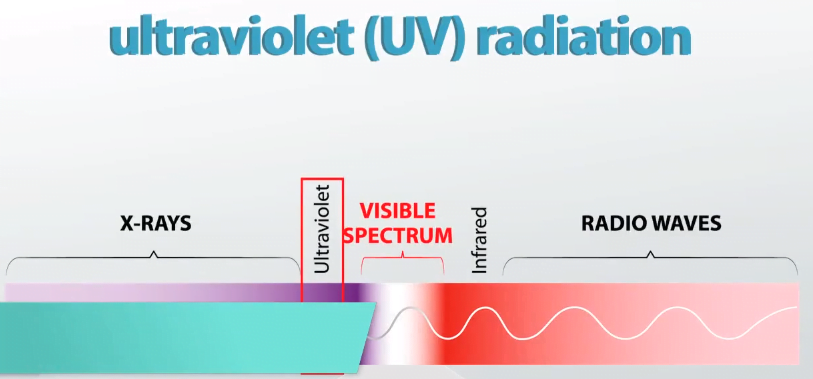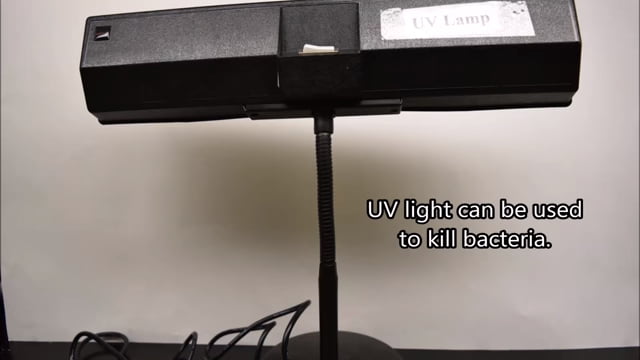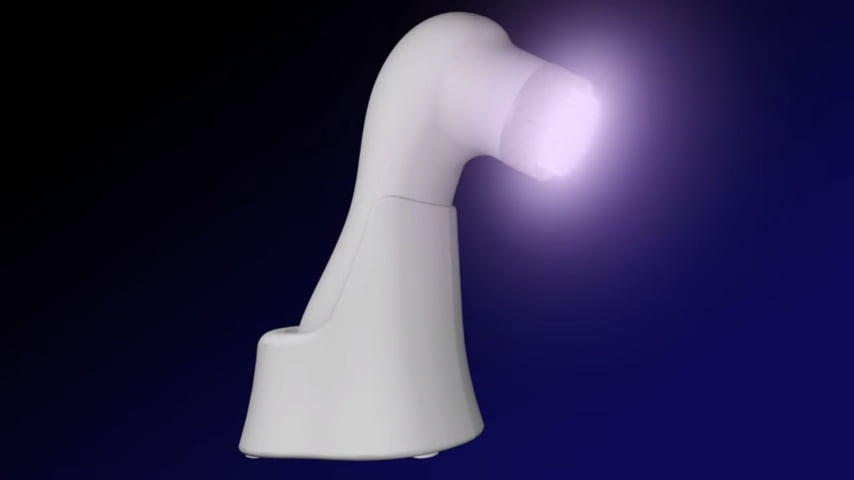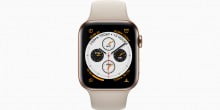Ultraviolet light is a type of electromagnetic radiation.
Ultraviolet light is responsible for summer tans and sunburns. However, too much exposure to UV radiation is damaging to the living tissue.
Ultraviolet light is not detectable by the human eye. But there are some insects that are able to see ultraviolet light. Our bodies use ultraviolet light to make vitamin D. If the ultraviolet light exposure is too much then it can be very harmful as it can cause cancer.
When Ultraviolet light descends on certain materials, ultraviolet light may cause them to fluoresce. It emits electromagnetic radiations of lower energy such as visible light.

The range of ultraviolet light:
Ultraviolet radiation lies between wavelengths of about 400 nanometers (1 nanometer [nm] is 10-9metre) on the visible-light side and about 10 nm on the X-ray side, though some authorities extend the short-wavelength limit to 4 nm.
Regions in which ultraviolet light is divided:
Ultraviolet radiation is commonly divided into four regions:
- near (400–300 nm)
- middle (300–200 nm)
- far (200–100 nm)
- extreme (below 100 nm)
Divisions of ultraviolet light:
Based on the interaction of wavelengths of ultraviolet radiation with biological materials, three divisions have been designated:
- UVA (400–315 nm): It is also called black light.
- UVB (315–280 nm): It is responsible for the radiation’s best-known effects on organisms.
- UVC (280–100 nm): It does not reach the earth’s surface.
How ultraviolet light is produced?
Ultraviolet radiation is produced by high-temperature surfaces, such as the Sun.
It is produced in a continuous spectrum and by atomic excitation in a gaseous discharge tube as a discrete spectrum of wavelengths.
Most of the ultraviolet radiation in sunlight is absorbed by oxygen in the Earth’s atmosphere, which forms the ozone layer of the lower stratosphere. Of the ultraviolet that does reach Earth’s surface, almost 99 percent is UVA radiation.

An ultraviolet UV lamp
An ultraviolet UV lamp has been developed that basically kills the influenza virus. A study has shown that it is not injurious to human eyes, skin, and health.

Objective:
The objective of this technology is to intercept the outspread of seasonal flu in public places such as schools, hospitals, restaurants, libraries, offices, parks, stores, etc. Ultraviolet light is especially effective and efficient in killing germs, microbes, bacteria, and viruses.
UV devices:
There are UV devices that have been used for sterilization and for the medical equipment in the hospitals.
But the conventional germicidal lamp is not safe for the humans when they are around.
Can Coronavirus be killed with UV Light?
There’s only one type of UV that can reliably inactivate Covid-19 – and it’s extremely dangerous.
BBC.com
According to BBC.com and some researchers, it’s not a good idea and even not possible. Learn more here.
UV light can effectively kill airborne influenza:
UV light can effectively kill airborne influenza. It can kill bacteria without harming human tissues. A study has shown that broad-spectrum germicidal UV light that has a wavelength between 200 to 400 nanometers is extremely active and efficient in killing bacteria, microbes, and viruses by spoiling the molecular bonds that hold the DNA together.
This conventional UV light is used to sterilize the medical equipment. The conventional germicidal UV is also harmful to human health. It can cause skin cancer.
Brenner and his colleagues hypothesized that a narrow spectrum of ultraviolet light called far-UVC could destroy microbes without damaging healthy tissue.
UVC light has a very limited range and it cannot go through the outer dead cell layer of human skin or the tear layer in the eye. However, it is not harmful to human health.

Conclusion:
Ultra-violet rays can provide numerous benefits of sterilization i.e. the removal of microbes and viruses from the equipment. It can definitely reduce the transmission of illnesses caused by them. There is special stress on the transmission of the influenza virus but the practical use of ultraviolet rays is beyond the removal of these viruses.
Disclaimer: NewTech21 is a participant in the Amazon Services LLC Associates Program. As an Amazon Associate, we earn from qualifying purchases by linking to Amazon.com and affiliated sites. For more info, please read our disclaimer.




Great article. The use of UV light has lead to the saying that “sunlight is the best disinfectant.” And as to viruses, it is obvious that during summer seasons globally, the incidence of flu and colds is profoundly reduced. These seasons of course, are those in which the people go outside to soak up some sun. UV exposure from sunlight or sunlamps is also used to disinfect water, toothbrushes and even blood. I love articles that tell the truth about sunlight and UV light in general.
For more information and references: sunlightinstitute.org. Or, read Dr. Marc Sorenson’s new book, Embrace the Sun, available at Amazon.
Whether ultraviolet lamp kill covid-19.
Whether x-ray will kill covid19.how to make a x-rays in house as ultraviolet bulb or emissions.is there is any way to make our normal electric arc bulb to emit ultraviolet or x-rays.iam from country India .
To Balachandar, there was a device that emitted low power x-rays (next in the spectrum to biocidal UV) in almost all homes throughout most of the world – the CRT television. The later models of CRT TV and computer monitors were engineered to emit less of this germicidal radiation, and the flat screen TVs that replaced them don’t emit any. The high voltage in CRT TVs may also have produced ionisation of the air which also potentially degrades virus.
Can blk light / UV Light 365nm kill bacteria and Viruses? Also is there a height the UV light should be positioned in order to kill the bacteria / viruses ? Thanks
Mr.Lee are you now in China.please immediately email me .
ravi4u2983@gmail.com.
I need your help
Mr.lee if you in China i wish to know about corona to try for protection we will both do try .
Can U V be used to sterilize disposable N95 masks for reuse
Did you receive a response? Can UV be used to sterilizer disposable N95?
I would like to know that too!
How long an exposure (minutes or hours) are these UV lamps effective in killing viruses?
How many Watts are necessary?
My exact questions as well!
How long an exposure (minutes or hours) are these UV lamps effective in killing viruses?
How many Watts are necessary?
It appears to be more about the intensity of the bulb. This site has a great chart that might give you an idea https://www.americanairandwater.com/uv-facts/uv-dosage.htm
No direct response to using U V to
Sterilize N45 masks – cdc
Any facilities that could respond
And help hospitals on front lines
Until surplus of N45
I am not medically trained in any way, but if uv can kill covid 19 could a endoscope
possibly be developed and used, using uv light, to treat covid 19 patients lungs thus killing the virus?
A couple of months ago, I purchased a bulb from China, after reading of the ability of the UV C being able to clean the air of mold and bacteria. I recently put the bulb in my back room, a room that I once used for a computer repair shop, but have since given up on that hobby. It is in a goose neck light, and aimed at the ceiling. I know it works as I can smell the ozone that it produces, and the black-light effect is obvious as well. I am thinking of moving that light around my home from room to room and allowing it to run for 30 minutes in each room to clens the air and surfaces. Do you see any danger in this process, so long as I keep everyone and the cats that live in our home away from the rooms being processed?
My search landed me into your site looking for info. The current understanding is that UV C (280-100nm) is effective in killing virus like covid 19
However you have indicated 200-400 nm. Bit confused